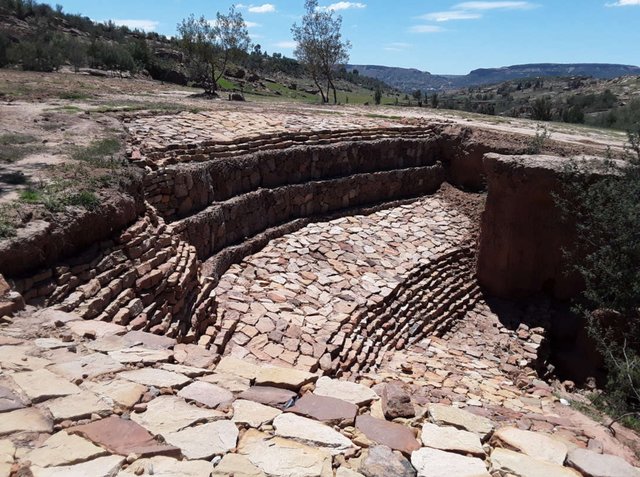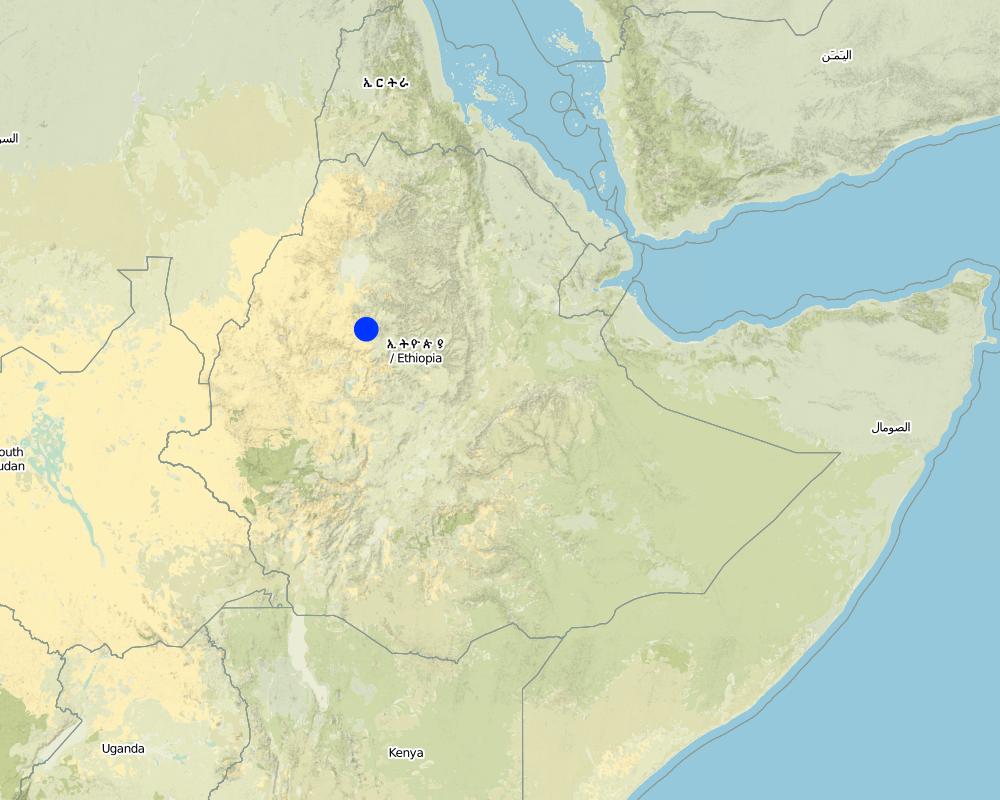Social Infrastructure for Soil Conservation [Эфиопия]
- Создание:
- Обновить:
- Составитель: Hans Hurni
- Редактор: –
- Рецензент: Fabian Ottiger
approaches_2390 - Эфиопия
Просмотреть разделы
Развернуть все Свернуть все1. Общая информация
1.2 Контактные данные специалистов и организаций, участвующих в описании и оценке Подхода
Название организации (-ий), содействовавших документированию/оценке Подхода (если применимо)
CDE Centre for Development and Environment (CDE Centre for Development and Environment) - Швейцария1.3 Условия, регламентирующие использование собранных ВОКАТ данных
Составитель и ответственный/-ые специалист(-ы) согласны с условиями, регламентирующими использование собранных ВОКАТ данных:
Да
1.4 Ссылка (-и) на Анкету (-ы) по Технологиям УЗП

Gully head structure [Лесото]
The aim of the gully head structure is to help stabilise the gully and prevent/control the gully from expanding further in length due to erosion. In Lesotho, this is constructed using stones.
- Составитель: Matoka Moshoeshoe
2. Описание Подхода УЗП
2.1 Краткое описание Подхода
Negotiation with the stakeholder community of a catchment on social incentives to be offered by external agency in exchange of additional inputs by the communty to be invested into soil and water conservation measures.
2.2 Подробное описание Подхода
Подробное описание Подхода:
Aims / objectives: The overall purposeof the approach is to achieve sustainable land management without direct incentives such as food-for-work, cash payment, etc. Instead, the community is contracted through a negotiation process to invest into conservation without any direct incentives. Instead, the community will be entitled to select a social investment in their territory which conforms to its most pressing needs, e.g. a clinic, a school, a road, etc. Specific objective is to persuade farmers of the virtue of sustainable land management without direct pay, and to show that outside help is tied to this long-term community commitment when investing into social infrastrcuture. In the end, this is a win-win situation because two goals are achieved with a much greater investment and commitment from the farmer side, while sustainable land management and social development are furthered.
2.5 Страна/ регион/ место, где применялся Подход
Страна:
Эфиопия
Административная единица (Район/Область):
Gojam
Map
×2.6 Даты начала и окончания реализации Подхода
Год начала реализации:
1985
Год окончания (Если Подход больше не применяется):
1988
2.7 Тип Подхода
- в рамках проекта/ программы
2.8 Каковы цели/ задачи Подхода
The Approach focused mainly on SLM with other activities (Area closure / cut & carry of grass. Clinic construction & facilitation.)
There is no document, but the SCRP goal is to support sustainable use of natural resources. In Anjeni this should be achieved through a specific incentive at social level.
The SLM Approach addressed the following problems: Accelerating soil erosion. Declining production of crops. Overland runoff destroying crops and producing gullies. Poor social infrastructure in community.
2.9 Условия содействующие применению Технологии/ Технологий в рамках Подхода или затрудняющие его
Социальные/ культурные/ религиозные нормы и ценности
- затрудняют
lack of community collaboration
Treatment through the SLM Approach: further processes of community development
Институциональные условия
- затрудняют
lack of trained extensionists
Treatment through the SLM Approach: training supprt
Нормативно-правовая база (землевладение, права на земле- и водопользование)
- затрудняют
lack of land ownership
Treatment through the SLM Approach: clarify ownership and user rights
The existing land ownership, land use rights / water rights hindered a little the approach implementation But not much. Attitudes of farmers towards investments into their land remain negative.
3. Участие и распределение ролей заинтересованных сторон
3.1 Заинтересованные стороны, участвующие в реализации Подхода и их роли
- местные землепользователи/ местные сообщества
Groups of users organised through the project; Working land users were mainly men (Some women and children also participated.)
Women were less involved in planning and implementation of SWC, but more with social infrastructure. In Ethiopia, men traditionally do soil labour in field. The approach included all communities including all households.
- государственные власти (отвечающие за планирование или принятие решений)
Ministry of Agriculture
Ministry of Health
- международные организации
Если участвовало несколько заинтересованных сторон, назовите ведущую организацию:
Expat: Overall principle of conservation for infrastructure approach. Nationals: Design of objectives, activities. Land users: Agreement on approach and specific designs of technology & maintenance.
3.2 Участие местных землепользователей/ местных сообществ на разных стадиях реализации Подхода
| Участие местных землепользователей/ местных сообществ | Перечислите участников и опишите их вовлеченность | |
|---|---|---|
| инициирование/ мотивация | нет | |
| планирование | пассивное | interviews/questionnaires |
| выполнение | пассивное | responsibility for major steps |
| мониторинг/ оценка | пассивное | public meetings; |
| Research | нет |
3.4 Принятие решений по выбору Технологии/ Технологий УЗП
Укажите, кто принимал решение по выбору применяемой Технологии/ Технологий:
- преимущественно специалисты по УЗП после консультаций с землепользователями
Поясните:
consultative. Development of technology was based on existing indigenous technologies which were complemented and perennized. The approach was explained to the farmers, a 10ha demonstration area was established for one year, and the agreement was reached after that time to do it on 100 ha, if social infrastructure support was given.
Decisions on the method of implementing the SLM Technology were made by by SLM specialists alone (top-down). directive (top-down). Proposal by Development Agents was explained to farmers, and their consent used to organize the mass implementation campaign in 1987.
4. Техническая поддержка, повышение компетенций и управление знаниями
4.1 Повышение компетенций/ обучение
Проводилось ли обучение землепользователей/ других заинтересованных лиц?
Да
Укажите, кто проходил обучение:
- землепользователи
- SWC specialists (2), extensionists/trainers (1), politicians/decision makers (1)
Тип обучения:
- в ходе работы
- опытные участки
- общие собрания
Рассматриваемые темы:
Technical design of SWC techniques. Institutions on maintenance & modifications.
4.2 Консультационные услуги
Есть ли у землепользователей возможность получать консультации?
Да
Укажите, где именно оказываются консультационные услуги:
- на полях землепользователей
Описание/ комментарий:
Name of method used for advisory service: Government Extension System.; Key elements: Holding of meetings., Technical layout of SWC techniques., Support in negotiations & follow-up.; 1) Mainly: government's existing extension system, Partly: projects own extension structure and agent; Extension staff: Mainly government employees 2) Target groups for extension: School children/students, Teachers; Activities: Demonstration visits to nearby catchment and preparation of a school b
Advisory service is inadequate to ensure the continuation of land conservation activities; Farmer to extensionist ratio is 1000:1 or worse. Educational status of all is low. Approach of extension still needs improvement.
4.3 Институциональная (организационная) поддержка
В ходе реализации Подхода были ли организованы новые институциональные структуры или поддержаны уже существующие?
- да, умеренно
Укажите уровень, на котором структуры были укреплены или вновь созданы:
- местные
Укажите тип поддержки:
- оборудование
4.4 Мониторинг и оценка
Являются ли мониторинг и оценка частью Подхода?
Да
Комментарии:
bio-physical aspects were regular monitored through observations
technical aspects were regular monitored through observations
socio-cultural aspects were regular monitored through observations
economic / production aspects were regular monitored through measurements
There were several changes in the Approach as a result of monitoring and evaluation: Technology was adapted according to farmers wishes, namely adjustments of narrow terraces by removing some, overlay of drainage system over terraces and not along them.
Monitoring & extension in still ongoing through SCRP, and since 1984 in Anjeni.
4.5 Научные исследования
Были ли научные исследования частью Подхода?
Да
Укажите темы исследований:
- социология
- экономика / маркетинг
- экология
- технология
- Land use dynamics, farming system.
Напишите подробнее и назовите тех, кто выполнял исследования:
The treated catchment of Anjeni is part of a research set-up where continuous monitoring and evaluation is being carried out since 1984.
Research was carried out on-farm
5. Финансирование и внешняя материальная поддержка
5.1 Годовой бюджет мероприятий по УЗП в рамках Подхода
Если точный годовой бюжет неизвестен, укажите примерный диапазон затрат:
- 10000-100000
Комментарий (например, основные источники финансирования/ ключевые доноры):
Approach costs were met by the following donors: international (GDE/SCRP): 25.0%; government (national - Min. of Agriculture): 5.0%; local community / land user(s) (-): 70.0%
5.2 Финансирование и внешняя материальная поддержка, предоставляемая землепользователям
Предоставлялась ли землепользователям финансовая/ материальная поддержка для применения Технологии /Технологий?
Да
5.3 Субсидии на отдельные затраты (включая оплату труда)
- оборудование
| Укажите, какие ресурсы были субсидированы | В какой степени | Опишите субсидии подробнее |
|---|---|---|
| инвентарь/ инструменты | профинансированы полностью | Hand tools |
- инфраструктура
| Укажите, какие ресурсы были субсидированы | В какой степени | Опишите субсидии подробнее |
|---|---|---|
| Community infrastructure | профинансированы частично | Support to clinic was 50% of cost of clinic only. |
Если труд землепользователя был существенным вкладом, укажите, был ли этот вклад:
- добровольный
Комментарии:
In exchange of SWC works support to clinic was given as an overall incentive.
5.4 Кредитование
Предоставлялись ли в рамках Подхода кредиты на мероприятия УЗП?
Нет
6. Анализ влияния и заключительные положения
6.1 Влияние Подхода
Сумел ли Подход помочь землепользователям внедрить и поддерживать технологии УЗП?
- Нет
- Да, немного
- Да, умеренно
- Да, существенно
Traditional soil fertility management was already exhaustively used under the given farming system.
Сумел ли Подход разрешить правовые проблемы землевладения/ землепользования, препятствующие использованию технологий УЗП?
- Нет
- Да, немного
- Да, умеренно
- Да, существенно
The problem is unlikely to be overcome in the near future. Present government insists on state ownership of land.
Did other land users / projects adopt the Approach?
- Нет
- Да, немного
- Да, умеренно
- Да, существенно
A large programme in Merhabete involving 2,000 ha and about 10,000 people adopted a similar system, however with a technology that was suitable to their area (level bunds).
6.3 Долгосрочная устойчивость мероприятий в рамках Подхода
Могут ли землепользователи самостоятельно (без внешней поддержки) продолжать применение того, что было реализовано в рамках Подхода?
- нет
Если нет или нет уверенности, объясните почему:
Social incentives will have to come from outside (government or NGO)
6.4 Сильные стороны/ преимущества Подхода
| Сильные стороны/ преимущества/ возможности по мнению землепользователей |
|---|
| Fulfillment of community needs (How to sustain/ enhance this strength: Co-ordination and participatory approach) |
| All catchment land users do conservation jointly together (How to sustain/ enhance this strength: Community versus individual approach) |
| Сильные стороны/ преимущества/ возможности по мнению составителя или других ключевых специалистов |
|---|
| Negotiation processes (How to sustain/ enhance this strength: Train extensionists) |
| Social incentives (How to sustain/ enhance this strength: Better cooperation between different ministries on their activities as a package) |
6.5 Слабые стороны/ недостатки Подхода и пути их преодоления
| Слабые стороны/ недостатки/ риски по мнению землепользователей | Возможные пути их преодоления/снижения? |
|---|---|
| Combining two goals necessitates more labour inputs | No solution |
| Слабые стороны/ недостатки/ риски по мнению составителя или ответственных специалистов | Возможные пути их преодоления/снижения? |
|---|---|
| Tieing social investments with soil conservation is politically difficult because two goals are pursued with one instrument | No option but continue |
| Interest may still be initiated basically from need and less from degradation | Awareness needs to be furthered still |
7. Справочные материалы и ссылки
7.1 Методы сбора/источники информации
- выезды на места, полевые обследования
- опросы землепользователей
7.2 Ссылки на опубликованные материалы
Название, автор, год публикации, ISBN:
SCRP Progress Reports
Где опубликовано? Стоимость?
SCRP, Addis Abeba
Название, автор, год публикации, ISBN:
Book Learning from Anjeni' (Amharic)'
Где опубликовано? Стоимость?
Min. of Education, Bahr Dar
Название, автор, год публикации, ISBN:
SCRP Research Reports
Где опубликовано? Стоимость?
SCRP, Addis Abeba
Ссылки и модули
Развернуть все Свернуть всеСсылки

Gully head structure [Лесото]
The aim of the gully head structure is to help stabilise the gully and prevent/control the gully from expanding further in length due to erosion. In Lesotho, this is constructed using stones.
- Составитель: Matoka Moshoeshoe
Модули
Нет модулей


